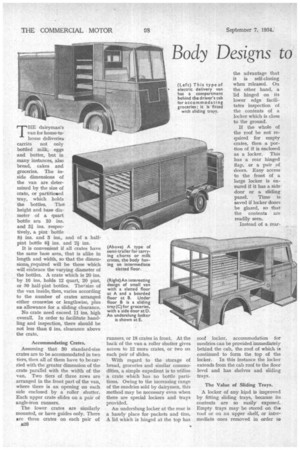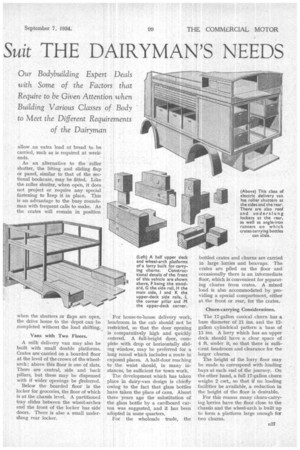Body Designs to
Page 40

Page 41

If you've noticed an error in this article please click here to report it so we can fix it.
Suit THE DAIRYMAN'S
NEEDS
THE dairyman's van for house-tohouse deliveries carries not only bottled milk, eggs and butter, but in runny instances, also bread, cakes and groceries. The inside dimensions of the van are determined by the size of crate, or partitioeted tray, which holds the bottles. Thd. height and base diameter of a quart bottle are 10 ins. and 31 ins, respectively, a pint bottle 83. ins. and 3 ins., and of a halfpint bottle 6. ins. and 2k• ins.
It is convenient if all crates have the same base area, that is alike in length and width, so that the dimensionsb„required will be those which will embrace the varying diameter of the bottles. A crate which is 20 ins. by 16 ins. holds 12 quart, 20 pint, or S0 half-pint bottles. Thee Size of the van inside, then, varies according to the number of crates arranged either crosswise or lengthwise, plus an allowance for a sliding clearance.
No crate need exceed 11 ins, high overall. In order to facilitate handling and inspection, there should be not less than 6 ins. clearance above the crate.
Accommodating Crates.
Assuming that 30 standard-size crates are to be accommodated in two tiers, then all of them have to be carried with the greater dimension of the crate parallel with the width of the van. Two tiers of three rows are arranged in the front part of the van, where there is art opening on each side enclosed by a roller shutter. Each upper crate slides on a pair of angle-iron runners.
The lower crates are similarly mounted, or have guides only. There are three crates on each pair of B26 runners, or 18 crates in front. At the back of the van a roller shutter gives access to 12 more crates, or two on each pair of slides.
With regard to the storage of bread, groceries and similar commodities, a simple expedient is to utilize a crate which has no bottle partitions. Owing to the increasing range of the sundries sold by dairymen, this method may be necessary even when there are special lockers and trays provided.
An underslung locker at the rear is a handy place for packets and tins. A lid which is hinged at the top has e
roof locker, accommodation for sundries can be provided immediately behind the cab, the roof of which is continued to form the top of the locker. In this instance the locker extends from the cab roof to the floor level and has shelves and sliding trays.
The Value of Sliding Trays.
A locker of any kind is improved by fitting sliding trays, because its contents are so easily exposed. Empty trays may be stored on the roof or on an upper shelf, or intermediate ones removed in order to
allow an extra load of bread to be carried, such as is required at weekends.
As an alternative to the roller shutter, the lifting and sliding flap or panel, similar to that of the sectional bookcase, may be fitted. Like the roller shutter, when open, it does not project or require any special fastening to keep it in place. This is an advantage to the busy roundsman with frequent calls to make. As the crates will remain in position when the shutters or flaps are open, the drive home to the depot can be completed without the load shifting.
Vans with Two Floors.
A milk delivery van may also be built with small double platforms. Crates are-carried on a boarded floor at the level of the crown of the wheelarch ; above this floor is one of slats. There are central, side and back pillars, but these may be dispensed with if wider openings be preferred.
Below the boarded floor is the locker for groceries, the floor of which is at the chassis level. A partitioned tray slides between the wheel-arches and the front of the locker has side doors. There is also a small underslung rear locker. For house-to-house delivery work, headroom in the cab should not be restricted, so that the door opening is comparatively high and quickly entered. A full-height door, complete with drop or horizontally sliding window, may be preferred for a long round which includes a route in exposed places. A half-door reaching to the waist should, in many instances, be sufficient for town work.
The development which has taken place in dairy-van design is chiefly owing to the fact that glass bottles have taken the place of cans. About three years ago the substitution of the glass bottle by a cardboard carton was suggested, and it has been adopted in some quarters.
For the wholesale trade, the bottled crates and churns are carried in large lorries and boxvaris. The crates are piled on the floor and occasionally there is an intermediate floor, which is convenient for separating churns from crates. A mixed load is also accommodated by providing a special compartment, either at the front or rear, for the crates.
Churn-carrying Considerations.
The 17-gallon conical churn has a base diameter of 21 ins, and the 12gallon cylindrical pattern a base of 15 ins. A lorry which has an upper deck should have a clear space of 4 ft. under it, so that there is sufficient headroom and clearance for the larger churns.
The height of the lorry floor may be made to correspond with loading bays at each end of the journey. On the other hand, a full 17-gallon churn weighs 2 cwt., so that if no loading facilities be available, a reduction in the height of the floor is desirable.
For this reason many churn-carrying lorries have the floor close to the Chassis and the wheel-arch is built up to form a platform large enough for two churns.




























































































